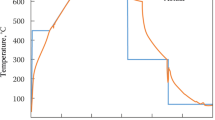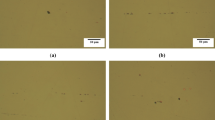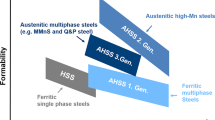Future work is determined on the basis of analyzing experience in the development of world automobile manufacture for optimizing alloying and production parameters for manufacturing high-strength low-alloy steels. On the basis of analyzing thermodynamic conditions for excess phase separation, a comprehensive study of the structure and the properties of hot-rolled high-strength low-alloy steel product, alloying systems and key production parameters are determined that make it possible to prepare in a 2000 mill of Severstal rolled product 2–3 and 6 mm thick with a yield strength of not less than 460–500 N/mm2. Comparative evaluation of the potential of different alloying systems has demonstrated the advantages of microalloying with niobium and titanium for the best grain refinement and provision of a high and stable set of properties for rolled product of the strength level in question.
Similar content being viewed by others
References
N. G. Shaposhnikov, B. M. Mogutnov, S. M. Polonskaya, et al., “Thermodynamic modelling as an instrument for improving steel 12Kh18N10T steel ingot heating technology for rolling,” Materialovedenie, No. 11, 2–9 (2004).
N. G. Shaposhnikov, A. A. Kononov, and B. M. Mogutnov, “Thermodynamic conditions for forming austenite grain growth inhibitors in structural steels of the pearlitic class,” Metally, No. 5, 5–12 (2004).
K. Inoue, N. Ishikawa, I. Ohnuma, et al., “Calculation of phase equilibria between austenite and (Nb, Ti, V)(C, N) in microalloyed steels,” ISIJ Int., 41, No. 2, 175–182 (2001).
B. Dutta and C. M. Sellars, “Effect of composition and process variables on Nb(C, N) precipitation in niobium microalloyed austenite,” Mater. Sci. Techn., 3, No. 3, 193–206 (1987).
H. Kejian and T. N. Baker, “Complex carbonitrides in multi-microalloyed Ti-containing HSLA steels and their influence on mechanical properties,” in: Titanium Technology in Microalloyed Steels, Inst. of Materials, London (1997).
K. Hylka, The Role of Niobium in Low Carbon Bainitic HSLA Steel, Department of Materials Science and Metallurgy, University of Cambridge, www.msm.cam.ac.uk/phasetrans/2005/LINK/10.pdf.
R. Lagneborg, T. Siwecki, S. Zajac, and B. Hutchinson, The Role of Vanadium in Microalloyed Steels, Swedish Inst. for Metals Research, Stockholm, Sweden (1999).
Author information
Authors and Affiliations
Corresponding author
Additional information
T. M. Efimova and I. N. Chirkina from Bardin TsNIIchermet and S. V. Zhilenko from CherMK Severstal took part in this work.
Translated from Metallurg, No. 8, pp. 50–56, August, 2009.
Rights and permissions
About this article
Cite this article
Rybkin, N.A., Rodionova, I.G., Shaposhnikov, N.G. et al. Development of approaches for selecting the optimum alloying systems and production parameters for manufacturing hot-rolled high-strength low-alloy steels for automobile building. Metallurgist 53, 486 (2009). https://doi.org/10.1007/s11015-009-9186-4
Received:
Published:
DOI: https://doi.org/10.1007/s11015-009-9186-4




